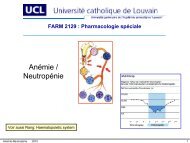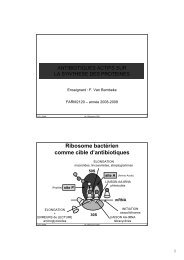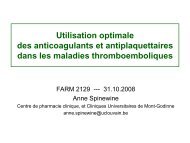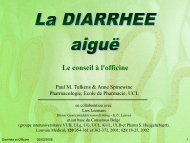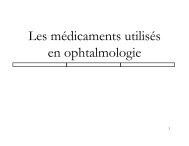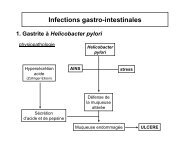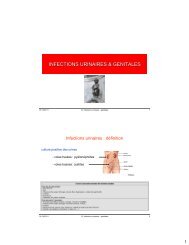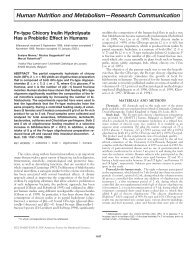A MBP-FAAH fusion protein as a tool to produce human and rat fatty ...
A MBP-FAAH fusion protein as a tool to produce human and rat fatty ...
A MBP-FAAH fusion protein as a tool to produce human and rat fatty ...
Create successful ePaper yourself
Turn your PDF publications into a flip-book with our unique Google optimized e-Paper software.
Amino Acids (2008) 34: 127–133<br />
DOI 10.1007/s00726-007-0540-1<br />
Printed in The Netherl<strong>and</strong>s<br />
A <strong>MBP</strong>-<strong>FAAH</strong> <strong>fusion</strong> <strong>protein</strong> <strong>as</strong> a <strong><strong>to</strong>ol</strong> <strong>to</strong> <strong>produce</strong> <strong>human</strong> <strong>and</strong> <strong>rat</strong> <strong>fatty</strong> acid<br />
amide hydrol<strong>as</strong>e: expression <strong>and</strong> pharmacological comparison<br />
G. Labar 1;2 , F. V. Vliet 3 , J. Wouters 2;4 , <strong>and</strong> D. M. Lambert 1;2<br />
1 Unite de Chimie pharmaceutique et de Radiopharmacie, Ecole de Pharmacie, Faculte deMedecine,<br />
Universite catholique de Louvain, Bruxelles, Belgium<br />
2 Drug Design <strong>and</strong> Discovery Center, Belgium<br />
3 Institut de recherches microbiologiques Wiame, Bruxelles, Belgium<br />
4 Labora<strong>to</strong>ire de Chimie biologique structurale, Faculte des Sciences, Facultes universitaires Notre-Dame de la Paix, Namur, Belgium<br />
Received January 20, 2007<br />
Accepted February 23, 2007<br />
Published online May 4, 2007; # Springer-Verlag 2007<br />
Summary. Fatty acid amide hydrol<strong>as</strong>e (<strong>FAAH</strong>), a membrane-anchored enzyme<br />
responsible for the termination of endocannabinoid signalling, is an<br />
attractive target for treating conditions such <strong>as</strong> pain <strong>and</strong> anxiety. Inhibi<strong>to</strong>rs<br />
of the enzyme, optimized using rodent <strong>FAAH</strong>, are known but their pharmacology<br />
<strong>and</strong> medicinal chemistry properties on the <strong>human</strong> <strong>FAAH</strong> are<br />
missing. Therefore recombinant <strong>human</strong> enzyme would represent a powerful<br />
<strong><strong>to</strong>ol</strong> <strong>to</strong> evaluate new drug c<strong>and</strong>idates. However, the production of high<br />
amounts of enzyme is hampered by the known refractiveness of <strong>FAAH</strong> <strong>to</strong><br />
overexpression. Here, we report the successful overexpression of <strong>rat</strong> <strong>and</strong><br />
<strong>human</strong> <strong>FAAH</strong> <strong>as</strong> a <strong>fusion</strong> <strong>to</strong> the E. coli mal<strong>to</strong>se-binding <strong>protein</strong>, retaining<br />
catalytic properties of native <strong>FAAH</strong>. Several known <strong>FAAH</strong> inhibi<strong>to</strong>rs were<br />
tested <strong>and</strong> differences in their potencies <strong>to</strong>ward the <strong>human</strong> <strong>and</strong> <strong>rat</strong> <strong>FAAH</strong><br />
were found, underscoring the importance of using a <strong>human</strong> <strong>FAAH</strong> in the<br />
development of inhibi<strong>to</strong>rs.<br />
Keywords: Fatty acid amide hydrol<strong>as</strong>e – Endocannabinoid system –<br />
Protein overexpression – Fusion <strong>protein</strong>s – Inhibi<strong>to</strong>rs characterization –<br />
Mal<strong>to</strong>se-binding <strong>protein</strong><br />
Introduction<br />
In the early 90s, a major cellular signalling system involving<br />
endogenous lipids <strong>as</strong> molecular messengers w<strong>as</strong> discovered.<br />
Two G <strong>protein</strong>-coupled recep<strong>to</strong>rs, the cannabinoid<br />
recep<strong>to</strong>rs CB 1 <strong>and</strong> CB 2 were the first components of<br />
this system <strong>to</strong> be cloned, in 1990 (Matsuda et al., 1990)<br />
<strong>and</strong> 1993 (Munro et al., 1993), respectively.<br />
The CB 1 cannabinoid recep<strong>to</strong>r, highly expressed in the<br />
CNS, is mainly involved in regulation of pain, feeding<br />
<strong>and</strong> locomotion, where<strong>as</strong> the CB 2 cannabinoid recep<strong>to</strong>r is<br />
primarily implicated in immunomodulation <strong>and</strong> inflamma<strong>to</strong>ry<br />
processes.<br />
In 1994, an<strong>and</strong>amide (N-arachidonoylethanolamine,<br />
AEA), w<strong>as</strong> the first member of a family of endogenous<br />
lipids termed endocannabinoids <strong>to</strong> be identified. Other<br />
endocannabinoids – including 2-arachidonoyl glycerol,<br />
virodhamine <strong>and</strong> noladin ether – were soon isolated<br />
<strong>and</strong> characterized (see Lambert <strong>and</strong> Fowler, 2005 for<br />
a review).<br />
To date, four enzymes responsible for the termination<br />
of endocannabinoid signal have been identified by molecular<br />
cloning. These include <strong>fatty</strong> acid amide hydrol<strong>as</strong>e<br />
(<strong>FAAH</strong>) (Cravatt et al., 1996), monoacylglycerol lip<strong>as</strong>e<br />
(MAGL) (Karlsson et al., 1997), <strong>as</strong> well <strong>as</strong> the recently<br />
cloned N-acylethanolamine-hydrolyzing acid amid<strong>as</strong>e<br />
(NAAA) (Tsuboi et al., 2005) <strong>and</strong> <strong>fatty</strong> acid amide hydrol<strong>as</strong>e-2<br />
(<strong>FAAH</strong>-2) (Wei et al., 2006).<br />
Several lines of evidence support the therapeutic interest<br />
of modulating <strong>FAAH</strong> activity. For example, using a model<br />
of <strong>FAAH</strong> ð = Þ mice, Cravatt’s group pointed out the physiological<br />
relevance of <strong>FAAH</strong> in an<strong>and</strong>amide degradation<br />
<strong>and</strong> reported a phenotypic analgesia in mice lacking the<br />
enzyme (Cravatt et al., 2001; Lichtman et al., 2004b).<br />
This launched an effort <strong>to</strong>wards a thorough molecular<br />
<strong>and</strong> pharmacological characterization of the <strong>protein</strong>, <strong>as</strong><br />
well <strong>as</strong> the design of potent <strong>and</strong> selective <strong>FAAH</strong> inhibi<strong>to</strong>rs.<br />
An important breakthrough in the knowledge of<br />
<strong>FAAH</strong> w<strong>as</strong> achieved with the elucidation of the tridimensional<br />
structure of the <strong>rat</strong> <strong>FAAH</strong> (Bracey et al., 2002).<br />
This structure unravelled how this 579 a.a. <strong>and</strong> 63 kDa
128 G. Labar et al.<br />
enzyme organizes itself <strong>as</strong> a dimeric <strong>protein</strong>, with two<br />
channels able <strong>to</strong> accommodate both the lipophilic nature<br />
of its subst<strong>rat</strong>e <strong>and</strong> the more hydrophilic ethanolamine<br />
leaving group. Moreover, two highly hydrophobic<br />
a-helices (a18–a19) constitute a lipophilic plateau, most<br />
likely anchoring the <strong>protein</strong> <strong>to</strong> cellular membranes (see<br />
McKinney <strong>and</strong> Cravatt, 2005 for a review on the <strong>fatty</strong> acid<br />
amide hydrol<strong>as</strong>e).<br />
Medicinal chemistry endeavours led <strong>to</strong> the discovery of<br />
several cl<strong>as</strong>ses of inhibi<strong>to</strong>rs, including OL-135, an alphake<strong>to</strong>heterocycle<br />
derivative (Boger et al., 2000, 2005), <strong>and</strong><br />
URB597, a carbamate-type derivative (Kathuria et al.,<br />
2003; Tarzia et al., 2003). The inhibi<strong>to</strong>rs tested in vivo<br />
in rodent models showed analgesic <strong>and</strong> anxiolytic properties,<br />
further illust<strong>rat</strong>ing the therapeutic relevance of<br />
targeting this enzyme (Kathuria et al., 2003; Lichtman<br />
et al., 2004a).<br />
Me<strong>as</strong>urements of the potency of the new compounds<br />
were mainly conducted using <strong>rat</strong> brain membranes <strong>as</strong> enzyme<br />
source. However, given the potential of <strong>FAAH</strong> inhibi<strong>to</strong>rs<br />
in the treatment of several disorders such <strong>as</strong> anxiety<br />
<strong>and</strong> pain, efforts are aimed at obtaining potent <strong>and</strong> selective<br />
drug c<strong>and</strong>idates directed against the <strong>human</strong> enzyme.<br />
The use of <strong>human</strong> brain homogenates <strong>as</strong> a source of <strong>human</strong><br />
enzyme remains hardly conceivable, mainly for two<br />
re<strong>as</strong>ons. First, the availability of the material is of critical<br />
concern <strong>and</strong> second, the heterogenous nature of the<br />
prepa<strong>rat</strong>ion would hamper the data interpretation since<br />
pharmacological <strong>and</strong> biochemical evidences suggest that<br />
endocannabinoids are hydrolyzed by additional enzymes.<br />
Therefore the expression of a recombinant <strong>FAAH</strong> constitutes<br />
an answer <strong>to</strong> those concerns. Boger et al. reported<br />
the use of native <strong>and</strong> truncated (1–29) <strong>FAAH</strong> expressed<br />
in E. coli, b<strong>as</strong>ed on a pro<strong>to</strong>col published by Patricelli et al.<br />
(1998). However, <strong>fatty</strong> acid amide hydrol<strong>as</strong>e, <strong>and</strong> more<br />
particularly the <strong>human</strong> enzyme, is known <strong>to</strong> be resistant<br />
<strong>to</strong> overexpression in heterologous hosts such <strong>as</strong> E. coli,<br />
resulting in very poor yields (Patricelli et al., 1998; Sipe<br />
et al., 2002).<br />
In this context, the engineering of <strong>fusion</strong> <strong>protein</strong>s is a<br />
method widely used in order <strong>to</strong> obtain enhanced solubility<br />
<strong>and</strong> higher expression of the target <strong>protein</strong>s (Baneyx, 1999<br />
<strong>and</strong> references therein).<br />
We report here the heterologous expression of <strong>FAAH</strong><br />
fused <strong>to</strong> the mal<strong>to</strong>se-binding <strong>protein</strong>, <strong>as</strong> a powerful <strong><strong>to</strong>ol</strong><br />
<strong>to</strong> obtain <strong>rat</strong> <strong>and</strong> <strong>human</strong> <strong>FAAH</strong> in high yields. This recombinant<br />
<strong>MBP</strong>-<strong>FAAH</strong> therefore constitutes a useful <strong><strong>to</strong>ol</strong><br />
for the characterization of new enzyme inhibi<strong>to</strong>rs, <strong>as</strong> well<br />
<strong>as</strong> for the efficient comparison of inhibi<strong>to</strong>rs selectivity<br />
among species.<br />
For example, URB597, a <strong>rat</strong> <strong>FAAH</strong> inhibi<strong>to</strong>r with potent<br />
anxiolytic <strong>and</strong> analgesic activities, is shown here <strong>to</strong><br />
be less effective than expected on the <strong>human</strong> enzyme.<br />
Materials <strong>and</strong> methods<br />
Expression pl<strong>as</strong>mids<br />
Rat <strong>FAAH</strong> cDNA (kindly donated by Prof. N. Ueda, Kagawa University,<br />
Japan) <strong>and</strong> <strong>human</strong> <strong>FAAH</strong> cDNA (kindly donated by Prof. B. F. Cravatt,<br />
Scripps Research Institute, USA) were introduced in<strong>to</strong> pMAL-cRI vec<strong>to</strong>r<br />
(New Engl<strong>and</strong> BioLabs) <strong>as</strong> an EcoRI=SalI fragment. pMAL-cRI vec<strong>to</strong>r<br />
introduces the mal<strong>to</strong>se binding <strong>protein</strong> gene upstream of the inserted gene.<br />
Similarly <strong>to</strong> Patricelli et al. (1998), both <strong>FAAH</strong> genes encoded a truncated<br />
<strong>protein</strong> (1–29).<br />
The 6-His <strong>MBP</strong>-<strong>FAAH</strong> construct w<strong>as</strong> gene<strong>rat</strong>ed by PCR amplification<br />
<strong>and</strong> cloning in the pMAL-cRI vec<strong>to</strong>r. The Strep-tag <strong>MBP</strong>-<strong>FAAH</strong> construct<br />
w<strong>as</strong> gene<strong>rat</strong>ed by inserting <strong>FAAH</strong> gene <strong>as</strong> an EcoRI=XhoI fragmentin<strong>to</strong><br />
pASK43 pl<strong>as</strong>mid, followed by subcloning in the pMAL-cRI vec<strong>to</strong>r <strong>as</strong> an<br />
EcoRI=HindIII fragment.<br />
Protein expression<br />
Expression of <strong>FAAH</strong> fused <strong>to</strong> <strong>MBP</strong> (<strong>MBP</strong>-<strong>FAAH</strong>) w<strong>as</strong> carried out in the<br />
E. coli ER2508 strain (New Engl<strong>and</strong> BioLabs). At an O.D. of 0.6,<br />
cultures were induced by the addition of IPTG (0.3 mM). After 2 h of<br />
incubation at 37 C, cells were harvested by centrifugation, resuspended in<br />
buffer 1 (Tris 50 mM, NaCl 200 mM, DTT 10 mM pH 7.4) <strong>and</strong> lysed by<br />
sonication. An insoluble fraction containing <strong>FAAH</strong> activity w<strong>as</strong> then<br />
isolated by centrifugation (10,000 g for 35 min, 4 C). The <strong>MBP</strong>-<strong>FAAH</strong><br />
present in the soluble fraction w<strong>as</strong> submitted <strong>to</strong> further purification.<br />
Purification of recombinant <strong>human</strong> <strong>MBP</strong>-<strong>FAAH</strong><br />
Amylose purification<br />
The soluble fraction w<strong>as</strong> loaded on an amylose resin chroma<strong>to</strong>graphy<br />
column (New Engl<strong>and</strong> BioLabs). After w<strong>as</strong>hing the column with buffer<br />
1, the recombinant <strong>protein</strong> w<strong>as</strong> eluted by addition of mal<strong>to</strong>se 15 mM.<br />
Ion metal affinity chroma<strong>to</strong>graphy in native conditions<br />
The sample (resuspended in buffer 1, without DTT) w<strong>as</strong> loaded on<strong>to</strong> a<br />
nickel sepharose column. After w<strong>as</strong>hing, the recombinant <strong>protein</strong> w<strong>as</strong> eluted<br />
using an imidazole gradient (0–200 mM) in buffer 2 (Tris 50 mM, NaCl<br />
200 mM, pH 7.4).<br />
Purification of <strong>human</strong> <strong>MBP</strong>-<strong>FAAH</strong> in denaturing conditions<br />
After the centrifugation step, the insoluble fraction w<strong>as</strong> w<strong>as</strong>hed two times<br />
in buffer 3 (urea 2 M, Tris 20 mM, NaCl 500 mM, tri<strong>to</strong>n 2%, pH 8).<br />
The insoluble <strong>protein</strong>s were then solubilized in buffer 4 (guanidine 6 M,<br />
Tris 20 mM, NaCl 500 mM, imidazole 5 mM, b-mercap<strong>to</strong>ethanol 2 mM,<br />
pH 8). After centrifugation, the denatured <strong>protein</strong>s were submitted <strong>to</strong><br />
ion metal affinity chroma<strong>to</strong>graphy, <strong>and</strong> eluted using an imidazole<br />
gradient (0–500 mM).<br />
Purification on streptactin resin<br />
Soluble fraction (in Tris 20 mM, NaCl 200 mM, DTT 10 mM, CHAPS<br />
0.5%, pH 8.3) w<strong>as</strong> loaded on a streptactin resin chroma<strong>to</strong>graphy column<br />
(IBA <strong>protein</strong> <strong><strong>to</strong>ol</strong>s). After w<strong>as</strong>hing, recombinant <strong>protein</strong> w<strong>as</strong> eluted by<br />
addition of 2.5 mM desthiobiotin.
Expression <strong>and</strong> characterization of <strong>human</strong> <strong>and</strong> <strong>rat</strong> <strong>FAAH</strong> 129<br />
Fractions purity w<strong>as</strong> <strong>as</strong>sessed by st<strong>and</strong>ard polyacrylamide gels electrophoresis,<br />
followed by Coom<strong>as</strong>sie blue or silver staining. For Western blot<br />
studies, <strong>protein</strong>s were electrophoresed on acrylamide gels (Nupage 4–12%<br />
in Bis-Tris buffer, Invitrogen) <strong>and</strong> transferred on nitrocellulose membranes.<br />
Immunodetection w<strong>as</strong> then carried out using anti-<strong>MBP</strong> (New<br />
Engl<strong>and</strong> Biolabs) or anti-<strong>FAAH</strong> antibodies (Cayman).<br />
Enzyme <strong>as</strong>say<br />
Fatty acid amide hydrol<strong>as</strong>e activity w<strong>as</strong> me<strong>as</strong>ured using a method adapted<br />
from Omeir et al. (1995). Briefly, radiolabeled [ 3 H]-an<strong>and</strong>amide<br />
(American radiolabeled Chemicals, final concent<strong>rat</strong>ion 2 mM, 60 Ci=mol)<br />
w<strong>as</strong> incubated for 10 min at 37 C in the presence of recombinant <strong>MBP</strong>-<br />
<strong>FAAH</strong> <strong>protein</strong> in 200ml of reaction volume (<strong>as</strong>say buffer: Tris–HCl<br />
10 mM, EDTA 1 mM, BSA 0.1% (w=v), pH 7.6). An<strong>and</strong>amide hydrolysis<br />
w<strong>as</strong> s<strong>to</strong>pped by the addition of 400 ml of a cold methanol=chloroform<br />
(1–1) mixture. After centrifugation at 700 g for 5 min, radioactivity in the<br />
upper aqueous ph<strong>as</strong>e w<strong>as</strong> me<strong>as</strong>ured by liquid scintillation.<br />
To me<strong>as</strong>ure the inhibi<strong>to</strong>rs potency, compounds were diluted in the<br />
adequate solvent (DMSO, ethanol, or methyl acetate). The IC 50 were<br />
determined <strong>and</strong> the K i were calculated using the formula: K i ¼ IC 50 =<br />
(1 þ [AEA]=K m ). Phenylmethylsulfonylfluoride (PMSF) w<strong>as</strong> from Sigma,<br />
arachidonyltrifluoromethyl ke<strong>to</strong>ne (ATFMK) from Tocris, methyl arachidonyl<br />
fluorophosphonate (MAFP), cyclohexylcarbamic acid 3 0 carbamoylbiphenyl-3-yl<br />
ester (URB597) <strong>and</strong> phenyl hexanoyl oxazolopyridine<br />
(CAY10402) from Cayman Chemical, <strong>and</strong> cyclohexylcarbamic acid<br />
biphenyl-4-yl ester (compound 26 from Tarzia et al., named ‘‘Tar26’’<br />
herein) w<strong>as</strong> synthesized following Tarzia et al. (2003) procedure.<br />
Where specified, <strong>rat</strong> brain homogenates were used <strong>to</strong> compare an<strong>and</strong>amide<br />
hydrol<strong>as</strong>e activity. Briefly, male Wistar <strong>rat</strong>s (250–300 g) were<br />
purch<strong>as</strong>ed from IFFA-CREDO (Les Oncins, France). Following decapitation,<br />
brains were carefully dissected on ice. All the manipulations were<br />
performed at 0–4 C. Tissues were homogenized in 20 mM HEPES, 1 mM<br />
MgCl 2 , pH 7.0 using a potter <strong>and</strong> subsequently centrifuged for 20 min at<br />
36,000 g. The pellet w<strong>as</strong> resuspended in the same buffer <strong>and</strong> centrifuged<br />
again for 20 min at 36,000 g. The latter ope<strong>rat</strong>ion w<strong>as</strong> performed twice.<br />
The resulting pellet w<strong>as</strong> s<strong>to</strong>red at 80 C in a conservation buffer (50 mM<br />
Tris–HCl, 1 mM EDTA, 3 mM MgCl 2 , pH 7.6). All experiments on animals<br />
were approved by the institutional ethics committee, <strong>and</strong> the housing<br />
conditions were <strong>as</strong> specified by the Belgian Law of November 14, 1993,<br />
on the protection of labora<strong>to</strong>ry animals (agreement no. LA 1230315).<br />
<strong>FAAH</strong> (Patricelli et al., 1998; Sipe et al., 2002). Beside<br />
this, methods commonly used <strong>to</strong> improve the expression<br />
of <strong>protein</strong>s in E. coli include the coexpression of chaperones,<br />
the use of modified E. coli strains encoding tRNA’s<br />
for rare codons <strong>and</strong> the engineering of <strong>fusion</strong> <strong>protein</strong>s.<br />
In this context, several studies have highlighted the advantages<br />
of fusing target <strong>protein</strong>s <strong>to</strong> other ones, especially<br />
the mal<strong>to</strong>se-binding <strong>protein</strong>. For instance, Pl<strong>as</strong>modium<br />
falciparum falcipain-2 (Goh et al., 2003), Pseudomon<strong>as</strong><br />
aeruginosa Outer Membrane Protein OprD (Epp et al.,<br />
2001), alanine carrier <strong>protein</strong> (Kanamori et al., 1999) <strong>and</strong><br />
several GPCRs (Grisshamer et al., 1993; Stan<strong>as</strong>ila et al.,<br />
1999) have been successfully expressed by <strong>fusion</strong> <strong>to</strong> <strong>MBP</strong>.<br />
Two hypotheses explaining the role of <strong>MBP</strong> in successful<br />
overexpression involve the enhanced solubility of the p<strong>as</strong>senger<br />
<strong>protein</strong> when fused <strong>to</strong> <strong>MBP</strong> (Fox et al., 2003), <strong>as</strong><br />
well <strong>as</strong> the ability of <strong>MBP</strong> <strong>to</strong> act <strong>as</strong>, or <strong>to</strong> recruit, chaperones<br />
in the vicinity of the growing <strong>protein</strong>, thus helping<br />
the proper folding of the peptide (Baneyx, 1999; Kapust<br />
<strong>and</strong> Waugh, 1999).<br />
We therefore applied these st<strong>rat</strong>egies in order <strong>to</strong><br />
reach high levels of expression of the <strong>fatty</strong> acid amide<br />
hydrol<strong>as</strong>e.<br />
We <strong>produce</strong>d in high yield <strong>fatty</strong> acid amide hydrol<strong>as</strong>e<br />
<strong>as</strong> a <strong>fusion</strong> <strong>to</strong> mal<strong>to</strong>se binding <strong>protein</strong> (<strong>MBP</strong>-<strong>FAAH</strong>)<br />
in E. coli ER2508, a strain lacking the mal<strong>to</strong>se-binding<br />
<strong>protein</strong> gene (Fig. 1). Typical yields were of tens of<br />
milligrams by liter of culture medium. This should be<br />
compared with the 1–1.5 mg=l of medium obtained by<br />
Results <strong>and</strong> discussion<br />
Overexpression of <strong>fatty</strong> acid amide hydrol<strong>as</strong>e<br />
<strong>as</strong> a <strong>fusion</strong> <strong>to</strong> mal<strong>to</strong>se-binding <strong>protein</strong><br />
Fatty acid amide hydrol<strong>as</strong>e belongs <strong>to</strong> the recently discovered<br />
endocannabinoid system, <strong>and</strong> the therapeutical<br />
potential of this membrane-bound <strong>protein</strong> is currently<br />
explored, notably since its inhibition w<strong>as</strong> reported <strong>to</strong> induce<br />
analgesia <strong>and</strong> anxiolysis in rodents (Kathuria et al.,<br />
2003). Development of new drugs targeting more efficiently<br />
the <strong>human</strong> enzyme requires the production of a<br />
recombinant <strong>human</strong> <strong>FAAH</strong> <strong>protein</strong>. However, <strong>as</strong> it might<br />
be seen when considering the expression yield of the<br />
native <strong>protein</strong> in E. coli, <strong>FAAH</strong> is refrac<strong>to</strong>ry <strong>to</strong> overexpression.<br />
Indeed, <strong>human</strong> enzyme h<strong>as</strong> been reported <strong>to</strong><br />
be even more difficult <strong>to</strong> <strong>produce</strong> <strong>and</strong> purify than the <strong>rat</strong><br />
Fig. 1. Expression of <strong>MBP</strong>-<strong>FAAH</strong> in E. coli. Electrophoresis of soluble<br />
E. coli <strong>protein</strong>s via (a) Coom<strong>as</strong>sie blue staining, (b) Western blot using<br />
anti-<strong>FAAH</strong> antibody, before <strong>and</strong> following IPTG induction (2 h–37 C).<br />
The arrow indicates the b<strong>and</strong> corresponding <strong>to</strong> <strong>MBP</strong>-<strong>FAAH</strong> (105 kDa).<br />
c Silver staining: pellet <strong>and</strong> supernatant fractions after centrifugation<br />
(10,000 g) of the crude lysate
130 G. Labar et al.<br />
Patricelli et al. (1998). As can be seen in Fig. 1b, an antibody<br />
raised against the C-terminal part of the <strong>fatty</strong> acid<br />
amide hydrol<strong>as</strong>e only recognizes the overexpressed <strong>protein</strong><br />
with the expected molecular weight of 105 kDa.<br />
In order <strong>to</strong> ensure that fusing <strong>FAAH</strong> <strong>to</strong> mal<strong>to</strong>se binding<br />
<strong>protein</strong> does not result in an abolishment of the<br />
hydrol<strong>as</strong>e activity, we compared the activities of <strong>MBP</strong>-<br />
<strong>FAAH</strong> <strong>and</strong> an<strong>and</strong>amide hydrol<strong>as</strong>e from a <strong>rat</strong> brain<br />
homogenate. Kinetic parameters were found similar for<br />
the enzymes from both sources, with K m values of<br />
5.31 1.0 mM <strong>and</strong> 3.68 0.64 mM for <strong>rat</strong> <strong>MBP</strong>-<strong>FAAH</strong><br />
<strong>and</strong> an<strong>and</strong>amide hydrol<strong>as</strong>e from <strong>rat</strong> brain homogenates,<br />
respectively.<br />
It is interesting <strong>to</strong> note that the <strong>MBP</strong>-<strong>FAAH</strong> <strong>protein</strong> w<strong>as</strong><br />
found both in the supernatant <strong>and</strong> in the pellet fraction<br />
following centrifugation (Fig. 1c). Actually, the recombinant<br />
<strong>protein</strong> found in the insoluble fraction constitutes an<br />
enriched source of nearly pure enzyme, suitable for enzymatic<br />
studies <strong>and</strong> inhibi<strong>to</strong>rs evaluation.<br />
<strong>MBP</strong>-<strong>FAAH</strong> purification<br />
In an attempt <strong>to</strong> <strong>as</strong>sess if the overexpressed <strong>human</strong> <strong>MBP</strong>-<br />
<strong>FAAH</strong> could be amenable <strong>to</strong> structural studies purposes,<br />
the soluble fraction w<strong>as</strong> submitted <strong>to</strong> purification.<br />
First, the affinity of the <strong>MBP</strong> moiety for amylose w<strong>as</strong><br />
exploited in a chroma<strong>to</strong>graphy column. This resulted in an<br />
enriched <strong>MBP</strong>-<strong>FAAH</strong> fraction (Fig. 2a).<br />
A second <strong>fusion</strong> <strong>protein</strong>, bearing a 6-his tag at C-term<br />
of the <strong>protein</strong> (<strong>MBP</strong>-<strong>FAAH</strong>-his), w<strong>as</strong> engineered in order<br />
<strong>to</strong> enhance the purification. Unfortunately, the affinity of<br />
<strong>MBP</strong>-<strong>FAAH</strong>-his for Ni þþ or Co þþ ion metals w<strong>as</strong> very<br />
low <strong>and</strong> no major purity improvement w<strong>as</strong> obtained.<br />
Different resins, including hydrophobic <strong>and</strong> anion- or<br />
cation-exchange resins, were then tested. The most promising<br />
results were obtained using an anion exchange<br />
chroma<strong>to</strong>graphy <strong>as</strong> first step of the purification scheme.<br />
Flow-through from this column, containing <strong>FAAH</strong> activity,<br />
w<strong>as</strong> subsequently loaded on an amylose column. This<br />
st<strong>rat</strong>egy led <strong>to</strong> a relative good level of purity, but unfortunately<br />
some impurities (with a molecular weight between<br />
50 <strong>and</strong> 100 kDa) were still present in the sample.<br />
In an effort <strong>to</strong> underst<strong>and</strong> the difficulties of purifying<br />
<strong>MBP</strong>-<strong>FAAH</strong> <strong>and</strong> <strong>to</strong> gain information concerning the nature<br />
of the contaminants, a Western Blot using antibodies<br />
raised against the <strong>MBP</strong> moiety w<strong>as</strong> performed. All the<br />
impurities present in the sample were detected by the<br />
anti-<strong>MBP</strong> antibody. Furthermore, it could be stated that<br />
these impurities only occur during the overexpression process<br />
(Fig. 3a). Therefore, we postulate that high expression<br />
level of <strong>MBP</strong>-<strong>FAAH</strong> in E. coli is accompanied by<br />
the co-expression of a series of by-products of the <strong>protein</strong><br />
(Fig. 3), that could not be sepa<strong>rat</strong>ed from the complete<br />
<strong>MBP</strong>-<strong>FAAH</strong>.<br />
If this <strong>as</strong>sumption is correct, the use of a C-term tag<br />
should allow <strong>to</strong> overcome the problem. However, <strong>as</strong> stated<br />
above, C-term 6-his tag did not result in any efficient<br />
binding of the <strong>protein</strong>. Therefore, we tried a C-term<br />
Strep-tag, which allowed us <strong>to</strong> reach 90% of purity in one<br />
step, using a streptactin resin. As it can be seen in Fig. 2c,<br />
some expression by-products still remain in the eluted<br />
fraction, <strong>to</strong> a much lower extent though compared <strong>to</strong> the<br />
Fig. 2. Chroma<strong>to</strong>graphic purification of <strong>MBP</strong>-<strong>FAAH</strong>. a Purification of<br />
<strong>MBP</strong>-<strong>FAAH</strong> on an amylose resin: 1 supernatant fraction; 2 elution from<br />
amylose column (mal<strong>to</strong>se 15 mM). b Ion metal affinity chroma<strong>to</strong>graphy<br />
in denaturing conditions: 1 insoluble E. coli <strong>protein</strong> fraction in guanidine<br />
6M; 2 flow-through fraction; 3–4 elution from nickel resin. c Purification<br />
of <strong>MBP</strong>-<strong>FAAH</strong> on a streptactin column: 1 supernatant fraction; 2<br />
flow-through fraction; 3 elution from streptactin column<br />
Fig. 3. <strong>MBP</strong>-<strong>FAAH</strong> is co-expressed with lower molecular weight products<br />
in E. coli. a Electrophoresis of soluble E. coli <strong>protein</strong>s followed by<br />
anti-<strong>FAAH</strong> antibody revelation, before <strong>and</strong> following IPTG induction<br />
(2h–37 C). b Hypothesis of <strong>MBP</strong>-<strong>FAAH</strong> <strong>and</strong> <strong>MBP</strong>-<strong>FAAH</strong> by-products<br />
co-expression
Expression <strong>and</strong> characterization of <strong>human</strong> <strong>and</strong> <strong>rat</strong> <strong>FAAH</strong> 131<br />
<strong>protein</strong> purified using amylose affinity chroma<strong>to</strong>graphy.<br />
The difficulty <strong>to</strong> eliminate these impurities most probably<br />
reflects secondary interactions between some hydrophobic<br />
portions of the <strong>protein</strong>, resulting in soluble aggregates.<br />
Therefore, this method does not seem <strong>to</strong> be applicable<br />
<strong>to</strong> crystallization of <strong>human</strong> <strong>FAAH</strong>, <strong>as</strong> these non specific<br />
hydrophobic interactions lead <strong>to</strong> a non homogenous prepa<strong>rat</strong>ion.<br />
In addition, inefficient binding <strong>to</strong> the streptactin<br />
resin results in a loss of <strong>MBP</strong>-<strong>FAAH</strong> <strong>protein</strong> during the<br />
purification procedure. Nevertheless, using this method,<br />
the yield of purification w<strong>as</strong> of about 5 mg=l of culture<br />
medium.<br />
Noteworthy, the alternative st<strong>rat</strong>egies we used <strong>to</strong> enhance<br />
the expression level of <strong>FAAH</strong> in E. coli did not<br />
succeed. For example, the use of E. coli Rosetta strain,<br />
a strain known <strong>to</strong> give an answer <strong>to</strong> the rare codons problem,<br />
<strong>and</strong> of five different strains co-producing the chaperones<br />
DnaK, DnaJ, GrpE, GroES <strong>and</strong> GroEL (alone<br />
or in <strong>as</strong>sociation) did neither enhance the expression level<br />
of native <strong>FAAH</strong> nor improve the <strong>MBP</strong>-<strong>FAAH</strong> by-products<br />
coexpression problem (data not shown).<br />
Inhibi<strong>to</strong>r selectivity between <strong>rat</strong> <strong>and</strong> <strong>human</strong> <strong>FAAH</strong><br />
The second aim of this overexpression st<strong>rat</strong>egy w<strong>as</strong> <strong>to</strong><br />
provide an abundant <strong>and</strong> reliable source of enzyme in<br />
order <strong>to</strong> set up several enzymology studies. For instance,<br />
the high yield of bacterial expression of <strong>FAAH</strong> using<br />
<strong>fusion</strong> <strong>to</strong> mal<strong>to</strong>se-binding <strong>protein</strong> allows <strong>to</strong> screen for<br />
differences in <strong>FAAH</strong> inhibi<strong>to</strong>rs efficiencies or <strong>to</strong> compare<br />
inhibi<strong>to</strong>r selectivity among species. Human <strong>and</strong> <strong>rat</strong> enzymes<br />
share 82% amino acid identity (Giang <strong>and</strong> Cravatt,<br />
1997). Analysis of the tridimensional <strong>FAAH</strong> structure<br />
reveals that some of the differences in amino acids are<br />
found in the active site of the enzyme <strong>and</strong> therefore could<br />
result in changes in inhibi<strong>to</strong>r recognition.<br />
Along this line, a series of six well known <strong>FAAH</strong><br />
inhibi<strong>to</strong>rs – four irreversible inhibi<strong>to</strong>rs (i.e. URB597,<br />
Table 1. Inhibition potencies for an<strong>and</strong>amide hydrol<strong>as</strong>e activity on <strong>rat</strong><br />
<strong>and</strong> <strong>human</strong> <strong>MBP</strong>-<strong>FAAH</strong> <strong>fusion</strong> <strong>protein</strong>s. Potencies are expressed <strong>as</strong> pK i<br />
values (pK i ¼ log K i ). Values are the mean SEM of at le<strong>as</strong>t two<br />
experiments done in duplicate<br />
Rat<br />
Human<br />
PMSF 5.81 0.04 6.64 0.03<br />
ATFMK 7.41 0.02 7.91 0.04<br />
MAFP 8.69 0.04 9.48 0.09<br />
CAY10402 8.92 0.03 9.30 0.05<br />
‘‘Tar26’’ 7.08 0.03 7.35 0.05<br />
URB597 7.70 0.05 7.42 0.04<br />
‘‘Tar26’’, MAFP <strong>and</strong> PMSF) <strong>and</strong> two reversible compounds<br />
(i.e. ATFMK <strong>and</strong> CAY10402) – were studied for<br />
their ability <strong>to</strong> inhibit the <strong>rat</strong> <strong>and</strong> <strong>human</strong> enzymes. Thus<br />
the IC 50 were determined using both r<strong>FAAH</strong>-<strong>MBP</strong> <strong>and</strong><br />
h<strong>FAAH</strong>-<strong>MBP</strong> <strong>and</strong> the K i values were calculated.<br />
In five c<strong>as</strong>es, <strong>human</strong> recombinant <strong>FAAH</strong> seems <strong>to</strong> be<br />
more prone <strong>to</strong> inhibition than the <strong>rat</strong> <strong>protein</strong>, <strong>as</strong> summarized<br />
in Table 1. Indeed, the K <strong>rat</strong><br />
i =K <strong>human</strong><br />
i <strong>rat</strong>io ranged from<br />
1.85 for Tar26 <strong>to</strong> 6.75 for PMSF. However, in the c<strong>as</strong>e<br />
of URB597, it appears that the <strong>rat</strong> enzyme is more potently<br />
inhibited than the <strong>human</strong> one (K <strong>rat</strong><br />
i<br />
=K <strong>human</strong><br />
i ¼ 0.53).<br />
Actually, despite the 500 fold difference between URB597<br />
<strong>and</strong> ‘‘Tar26’’ IC 50 values on <strong>rat</strong> brain homogenates reported<br />
by Piomelli’s group (Tarzia et al., 2003; Kathuria<br />
et al., 2003), in our h<strong>and</strong>s the difference between these<br />
compounds in the same prepa<strong>rat</strong>ion reached only 4.<br />
Moreover, if we compare the inhibi<strong>to</strong>r potency for<br />
URB597 <strong>and</strong> ‘‘Tar26’’ on <strong>rat</strong> <strong>and</strong> <strong>human</strong> enzymes, we observe<br />
that this <strong>rat</strong>io of 4 is verified for the <strong>rat</strong> enzyme<br />
(4.14), <strong>and</strong> felt <strong>to</strong> 1.18 in the c<strong>as</strong>e of the <strong>human</strong> <strong>FAAH</strong>.<br />
If we compare it <strong>to</strong> other compounds, URB597 is 2<br />
<strong>and</strong> 80 times more potent than ATFMK <strong>and</strong> PMSF,<br />
respectively, on the <strong>rat</strong> enzyme. On the <strong>human</strong> <strong>FAAH</strong><br />
however, URB597 is only 6 times better than PMSF <strong>and</strong><br />
2 times less potent than ATMFK.<br />
These values suggest that URB597, despite being a<br />
potent inhibi<strong>to</strong>r of <strong>rat</strong> <strong>FAAH</strong> <strong>and</strong> showing interesting<br />
anxiolytic <strong>and</strong> analgesic properties in <strong>rat</strong>s, looses part of<br />
its potency when applied <strong>to</strong> <strong>human</strong> enzyme. Given that<br />
<strong>human</strong> <strong>and</strong> <strong>rat</strong> enzymes present 18% differences in amino<br />
acids, we can hypothesize that an interaction between <strong>rat</strong><br />
<strong>FAAH</strong> <strong>and</strong> URB597 is lost with the <strong>human</strong> enzyme.<br />
Conclusions<br />
In this study, different st<strong>rat</strong>egies in order <strong>to</strong> enhance the<br />
heterologous expression of both <strong>rat</strong> <strong>and</strong> <strong>human</strong> <strong>fatty</strong> acid<br />
amide hydrol<strong>as</strong>e in E. coli were applied. The most successful<br />
involved the expression of <strong>rat</strong> <strong>and</strong> <strong>human</strong> <strong>fatty</strong><br />
acid amide hydrol<strong>as</strong>e fused <strong>to</strong> mal<strong>to</strong>se binding <strong>protein</strong>.<br />
This st<strong>rat</strong>egy led <strong>to</strong> the expression of 50 mg=l of<br />
medium, 50 times higher compared <strong>to</strong> the native enzyme.<br />
This recombinant engineered <strong>protein</strong> is active <strong>and</strong> displays<br />
the same Michaelis constant (K m ) <strong>as</strong> the an<strong>and</strong>amide<br />
hydrol<strong>as</strong>e activity from <strong>rat</strong> brain homogenates, the<br />
commonly used <strong>FAAH</strong> source (Tarzia et al., 2003; Omeir<br />
et al., 1995).<br />
Interestingly, after expression in E. coli <strong>and</strong> centrifugation<br />
of the bacterial lysate, <strong>MBP</strong>-<strong>FAAH</strong> <strong>protein</strong> <strong>and</strong> activity<br />
localize in the insoluble, <strong>as</strong> well <strong>as</strong> in the soluble
132 G. Labar et al.<br />
fractions. Both can thus be used <strong>as</strong> source of <strong>FAAH</strong><br />
activity, since we did not observed differences between<br />
the enzymatic properties of these two fractions (data not<br />
shown). The fact that <strong>MBP</strong>-<strong>FAAH</strong> activity is notably<br />
found in the pellet after centrifugation could reflect the<br />
hydrophobic nature of the <strong>fatty</strong> acid amide hydrol<strong>as</strong>e<br />
(Bracey et al., 2004).<br />
Use of an antibody raised against the C-term part of the<br />
<strong>fusion</strong> <strong>protein</strong> (i.e. <strong>FAAH</strong>) only revealed one b<strong>and</strong>, at the<br />
expected molecular weight of 105 kDa. On the contrary,<br />
an antibody raised against the N-term <strong>MBP</strong> highlights a<br />
series of <strong>protein</strong>s, whose molecular weights range between<br />
50 <strong>and</strong> 100 kDa. Moreover, these contaminants<br />
are not present before induction (Fig. 3). Therefore, we<br />
postulated that the high level of expression in E. coli is<br />
accompanied by the production of several by-products,<br />
probably resulting from a premature s<strong>to</strong>p in transcription<br />
or translation. In agreement with this hypothesis, the use<br />
of a C-term his-tag for purification (in denaturing conditions)<br />
resulted in a pure <strong>protein</strong>, ruling out a possible role<br />
of proteolysis (Fig. 2b). Due <strong>to</strong> the poor affinity of the histag<br />
<strong>protein</strong> in native conditions, we gene<strong>rat</strong>ed a <strong>fusion</strong><br />
<strong>protein</strong> carrying a C-term Strep-tag. This small tag allowed<br />
us <strong>to</strong> purify the <strong>MBP</strong>-<strong>FAAH</strong> <strong>to</strong> a good extent (90%) in<br />
one step. However, this <strong>protein</strong> fraction does not seem <strong>to</strong><br />
be suitable for crystallographic purposes, since some products<br />
of lower molecular weight, whose elimination is problematic,<br />
still remain in the prepa<strong>rat</strong>ion.<br />
The high level of expression of <strong>fatty</strong> acid amide hydrol<strong>as</strong>e<br />
in <strong>fusion</strong> with <strong>MBP</strong>, besides further illust<strong>rat</strong>ing the<br />
interest of engineering target <strong>protein</strong>s refrac<strong>to</strong>ry <strong>to</strong> heterologous<br />
expression, permits the m<strong>as</strong>sive production of pure<br />
<strong>FAAH</strong> activity <strong>and</strong> therefore allows for the e<strong>as</strong>y onset of<br />
different kinetics <strong>and</strong> inhibi<strong>to</strong>rs characterization studies.<br />
For instance, in this study, we investigated the recognition<br />
profile of a series of six reversible <strong>and</strong> irreversible<br />
inhibi<strong>to</strong>rs on <strong>rat</strong> <strong>and</strong> <strong>human</strong> <strong>FAAH</strong> recombinant <strong>protein</strong>s.<br />
Among these compounds URB597, reported <strong>to</strong> have<br />
strong anxiolytic <strong>and</strong> analgesic properties in <strong>rat</strong> through<br />
inhibition of <strong>FAAH</strong> (Tarzia et al., 2003), proved <strong>to</strong> be less<br />
potent on the <strong>human</strong> enzyme <strong>as</strong> compared <strong>to</strong> the <strong>rat</strong> one.<br />
This once again illust<strong>rat</strong>es the caution needed when extrapolating<br />
inhibi<strong>to</strong>rs potencies from species <strong>to</strong> species, <strong>and</strong><br />
strengthens the need <strong>to</strong> design new compounds targeting<br />
the <strong>human</strong> enzyme.<br />
Acknowledgments<br />
The authors would like <strong>to</strong> greatly thank Professor B. F. Cravatt <strong>and</strong><br />
Professor N. Ueda for providing <strong>FAAH</strong> encoding pl<strong>as</strong>mids. We also thank<br />
Professor V. Stalon, C. Tricot <strong>and</strong> Y. Oudjama (Institut de recherches<br />
microbiologiques JM Wiame, Belgium) <strong>and</strong> Dr. G. G. Muccioli (Pharmacology<br />
Department, University of W<strong>as</strong>hing<strong>to</strong>n, USA) for very helpful<br />
discussion on <strong>protein</strong> expression <strong>and</strong> purification. This work w<strong>as</strong> supported<br />
by the FRFC (FNRS) no. 2.4654.06 grant.<br />
References<br />
Baneyx F (1999) Recombinant <strong>protein</strong> expression in Escherichia coli.<br />
Curr Opin Biotechnol 10: 411–421<br />
Boger DL, Sa<strong>to</strong> H, Lerner AE, Hedrick MP, Fecik RA, Miyauchi H,<br />
Wilkie GD, Austin BJ, Patricelli MP, Cravatt BF (2000) Exceptionally<br />
potent inhibi<strong>to</strong>rs of <strong>fatty</strong> acid amide hydrol<strong>as</strong>e: the enzyme responsible<br />
for degradation of endogenous oleamide <strong>and</strong> an<strong>and</strong>amide. Proc Natl<br />
Acad Sci USA 97: 5044–5049<br />
Boger DL, Miyauchi H, Du W, Hardouin C, Fecik RA, Cheng H, Hwang I,<br />
Hedrick MP, Leung D, Acevedo O, Guimaraes CR, Jorgensen WL,<br />
Cravatt BF (2005) Discovery of a potent, selective, <strong>and</strong> efficacious cl<strong>as</strong>s<br />
of reversible alpha-ke<strong>to</strong>heterocycle inhibi<strong>to</strong>rs of <strong>fatty</strong> acid amide<br />
hydrol<strong>as</strong>e effective <strong>as</strong> analgesics. J Med Chem 48: 1849–1856<br />
Bracey MH, Hanson MA, M<strong>as</strong>uda KR, Stevens RC, Cravatt BF (2002)<br />
Structural adaptations in a membrane enzyme that terminates endocannabinoid<br />
signaling. Science 298: 1793–1796<br />
Bracey MH, Cravatt BF, Stevens RC (2004) Structural commonalities<br />
among integral membrane enzymes. FEBS Lett 567: 159–165<br />
Cravatt BF, Giang DK, Mayfield SP, Boger DL, Lerner RA, Gilula NB<br />
(1996) Molecular characterization of an enzyme that degrades neuromodula<strong>to</strong>ry<br />
<strong>fatty</strong>-acid amides. Nature 384: 83–87<br />
Cravatt BF, Demarest K, Patricelli MP, Bracey MH, Giang DK, Martin<br />
BR, Lichtman AH (2001) Supersensitivity <strong>to</strong> an<strong>and</strong>amide <strong>and</strong> enhanced<br />
endogenous cannabinoid signaling in mice lacking <strong>fatty</strong> acid amide<br />
hydrol<strong>as</strong>e. Proc Natl Acad Sci USA 98: 9371–9376<br />
Epp SF, Pechere J, Kok M (2001) Raising antibodies against OprD, an<br />
outer membrane <strong>protein</strong> of Pseudomon<strong>as</strong> aeruginosa using translational<br />
<strong>fusion</strong>s <strong>to</strong> MalE. J Microbiol Methods 46: 1–8<br />
Fox JD, Routzahn KM, Bucher MH, Waugh DS (2003) Mal<strong>to</strong>dextrinbinding<br />
<strong>protein</strong>s from diverse bacteria <strong>and</strong> archaea are potent solubility<br />
enhancers. FEBS Lett 537: 53–57<br />
Giang DK, Cravatt BF (1997) Molecular characterization of <strong>human</strong> <strong>and</strong><br />
mouse <strong>fatty</strong> acid amide hydrol<strong>as</strong>es. Proc Natl Acad Sci USA 94:<br />
2238–2242<br />
Goh LL, Loke P, Singh M, Sim TS (2003) Soluble expression of a functionally<br />
active Pl<strong>as</strong>modium falciparum falcipain-2 fused <strong>to</strong> mal<strong>to</strong>sebinding<br />
<strong>protein</strong> in Escherichia coli. Protein Expr Purif 32: 194–201<br />
Grisshammer R, Duckworth R, Henderson R (1993) Expression of a <strong>rat</strong><br />
neurotensin recep<strong>to</strong>r in Escherichia coli. Biochem J 295: 571–576<br />
Kanamori M, Kamata H, Yagisawa H, Hi<strong>rat</strong>a H (1999) Overexpression of<br />
the alanine carrier <strong>protein</strong> gene from thermophilic bacterium PS3 in<br />
Escherichia coli. J Biochem (Tokyo) 125: 454–459<br />
Kapust RB, Waugh DS (1999) Escherichia coli mal<strong>to</strong>se-binding <strong>protein</strong> is<br />
uncommonly effective at promoting the solubility of polypeptides <strong>to</strong><br />
which it is fused. Protein Sci 8: 1668–1674<br />
Karlsson M, Contrer<strong>as</strong> JA, Hellman U, Tornqvist H, Holm C (1997) cDNA<br />
cloning, tissue distribution, <strong>and</strong> identification of the catalytic triad of<br />
monoglyceride lip<strong>as</strong>e. Evolutionary relationship <strong>to</strong> ester<strong>as</strong>es, lysophospholip<strong>as</strong>es,<br />
<strong>and</strong> haloperoxid<strong>as</strong>es. J Biol Chem 272: 27218–27223<br />
Kathuria S, Gaetani S, Fegley D, Valino F, Duranti A, Tontini A, Mor M,<br />
Tarzia G, La Rana G, Calignano A, Giustino A, Tat<strong>to</strong>li M, Palmery M,<br />
Cuomo V, Piomelli D (2003) Modulation of anxiety through blockade<br />
of an<strong>and</strong>amide hydrolysis. Nat Med 9: 76–81<br />
Lambert DM, Fowler CJ (2005) The endocannabinoid system: drug targets,<br />
lead compounds, <strong>and</strong> potential therapeutic applications. J Med<br />
Chem 48: 5059–5087<br />
Lichtman AH, Leung D, Shel<strong>to</strong>n CC, Saghatelian A, Hardouin C,<br />
Boger DL, Cravatt BF (2004a) Reversible inhibi<strong>to</strong>rs of <strong>fatty</strong> acid
Expression <strong>and</strong> characterization of <strong>human</strong> <strong>and</strong> <strong>rat</strong> <strong>FAAH</strong> 133<br />
amide hydrol<strong>as</strong>e that promote analgesia: evidence for an unprecedented<br />
combination of potency <strong>and</strong> selectivity. J Pharmacol Exp Ther 311:<br />
441–448<br />
Lichtman AH, Shel<strong>to</strong>n CC, Advani T, Cravatt BF (2004b) Mice lacking<br />
<strong>fatty</strong> acid amide hydrol<strong>as</strong>e exhibit a cannabinoid recep<strong>to</strong>r-mediated<br />
phenotypic hypoalgesia. Pain 109: 319–327<br />
Matsuda LA, Lolait SJ, Brownstein MJ, Young AC, Bonner TI (1990)<br />
Structure of a cannabinoid recep<strong>to</strong>r <strong>and</strong> functional expression of the<br />
cloned cDNA. Nature 346: 561–564<br />
McKinney MK, Cravatt BF (2005) Structure <strong>and</strong> function of <strong>fatty</strong> acid<br />
amide hydrol<strong>as</strong>e. Annu Rev Biochem 74: 411–432<br />
Munro S, Thom<strong>as</strong> KL, Abu-Shaar M (1993) Molecular characterization of<br />
a peripheral recep<strong>to</strong>r for cannabinoids. Nature 365: 61–65<br />
Omeir RL, Chin S, Hong Y, Ahern DG, Deutsch DG (1995) Arachidonoyl<br />
ethanolamide-[1,2-14C] <strong>as</strong> a subst<strong>rat</strong>e for an<strong>and</strong>amide amid<strong>as</strong>e. Life<br />
Sci 56: 1999–2005<br />
Patricelli MP, L<strong>as</strong>huel HA, Giang DK, Kelly JW, Cravatt BF (1998)<br />
Compa<strong>rat</strong>ive characterization of a wild type <strong>and</strong> transmembrane domaindeleted<br />
<strong>fatty</strong> acid amide hydrol<strong>as</strong>e: identification of the transmembrane<br />
domain <strong>as</strong> a site for oligomerization. Biochemistry 37: 15177–15187<br />
Sipe JC, Chiang K, Gerber AL, Beutler E, Cravatt BF (2002) A missense<br />
mutation in <strong>human</strong> <strong>fatty</strong> acid amide hydrol<strong>as</strong>e <strong>as</strong>sociated with problem<br />
drug use. Proc Natl Acad Sci USA 99: 8394–8399<br />
Stan<strong>as</strong>ila L, M<strong>as</strong>sotte D, Kieffer BL, Pattus F (1999) Expression of delta,<br />
kappa <strong>and</strong> mu <strong>human</strong> opioid recep<strong>to</strong>rs in Escherichia coli <strong>and</strong> reconstitution<br />
of the high-affinity state for agonist with heterotrimeric G<br />
<strong>protein</strong>s. Eur J Biochem 260: 430–438<br />
Tarzia G, Duranti A, Tontini A, Piersanti G, Mor M, Rivara S, Plazzi PV,<br />
Park C, Kathuria S, Piomelli D (2003) Design, synthesis, <strong>and</strong> structureactivity<br />
relationships of alkylcarbamic acid aryl esters, a new cl<strong>as</strong>s of<br />
<strong>fatty</strong> acid amide hydrol<strong>as</strong>e inhibi<strong>to</strong>rs. J Med Chem 46: 2352–2360<br />
Tsuboi K, Sun YX, Okamo<strong>to</strong> Y, Araki N, Tonai T, Ueda N (2005)<br />
Molecular characterization of N-acylethanolamine-hydrolyzing acid<br />
amid<strong>as</strong>e, a novel member of the choloylglycine hydrol<strong>as</strong>e family with<br />
structural <strong>and</strong> functional similarity <strong>to</strong> acid ceramid<strong>as</strong>e. J Biol Chem<br />
280: 11082–11092<br />
Wei BQ, Mikkelsen TS, McKinney MK, L<strong>and</strong>er ES, Cravatt BF (2006)<br />
A second <strong>fatty</strong> acid amide hydrol<strong>as</strong>e with variable distribution among<br />
placental mammals. J Biol Chem 281: 36569–36578<br />
Authors’ address: Didier M. Lambert, Unite de Chimie pharmaceutique<br />
et de Radiopharmacie, Universite catholique de Louvain, Avenue E.<br />
Mounier 73.40, 1200 Bruxelles, Belgique,<br />
Fax: þ3227647363, E-mail: lambert@cmfa.ucl.ac.be



